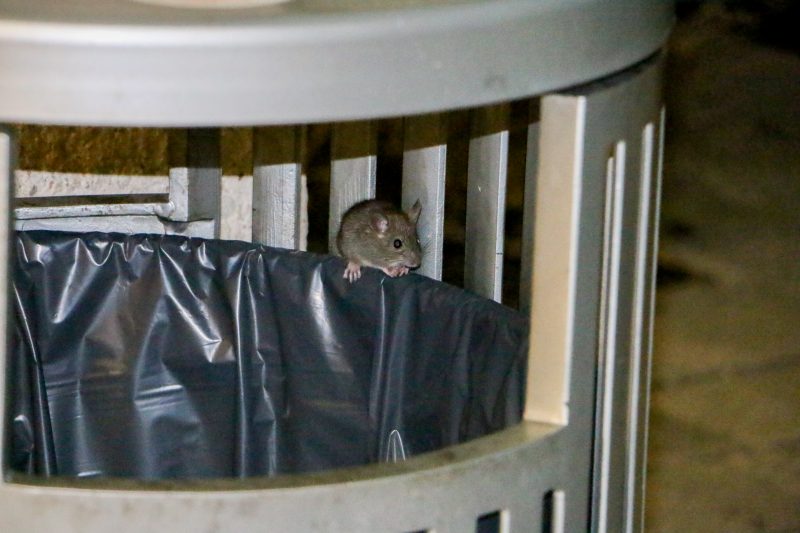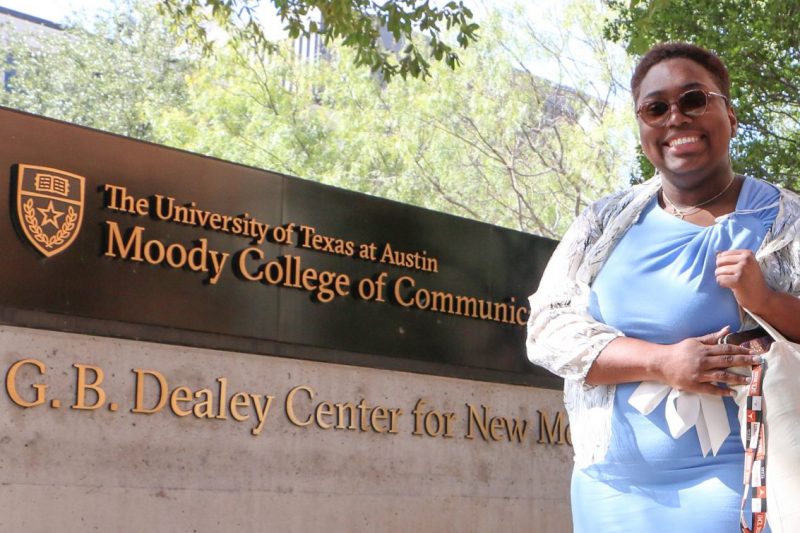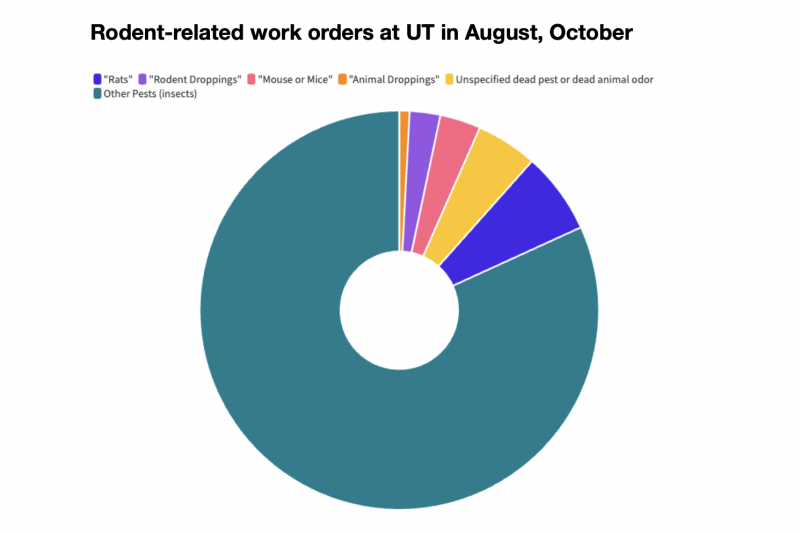Oh, Rats! Rodents on Campus Are UT’s Hidden Nightlife
By Abby L. Johnson
Reporting Texas

A rodent perches on the edge of a trash can just outside the G.B. Dealey Center for New Media on the University of Texas campus. It was one of many scurrying around in the early morning hours of Oct. 31. Abby L. Johnson/Reporting Texas
Clap.
Clap.
Clap.
The sun has yet to rise. There is a stillness outside the G.B. Dealey Center for New Media, home to the University of Texas’ Moody College of Communication. The sidewalks are devoid of students — it’s far too early for them to begin their sleepy shuffle from dorm rooms to their 8 a.m. classes. The only sounds that disturb the silence are the occasional whoosh of a car speeding down Guadalupe Street and the piercing, steady clap ringing out ominously in the otherwise tranquil pre-dawn hours.
On this early morning, a university custodian walks toward the Dealey Center with arms outstretched. Despite the cover of darkness, his presence is clearly announced by the loud clapping of his hands as he approaches the building.
The custodian claps to scatter the rodents that live in the south-facing courtyard of the communications building.
Watch: Custodian’s video of rats outside UT communications building
During the day, this courtyard is a space where Moody College of Communications students hang out, studying between classes or enjoying a snack or coffee drink from Cappy’s Café, located just inside.
At night, it’s a rodent’s covert playground. The kitten-sized creatures dart between the trash cans, hide in the vegetation and even climb trees, their beady eyes gleaming in the low light.
On one September morning, at least five rodents were caught on video as they scurried up and down the limbs of a tree in the corner of the courtyard. Several more are seen in the background of the video.
Sometimes, the little critters get bold and even make a surprise appearance during daylight hours. Kenedi Houston, a senior enrolled in the Moody College of Communication, recalled seeing a rodent running across the courtyard at the Dealey Center.

Kenedi Houston, a senior in the Moody College of Communication, witnessed a rat running across the Dealey Center courtyard. Abby L. Johnson/Reporting Texas
“I was surprised because I was sitting out on the patio over here, and I said what is that little scurrying thing over there? And it was like a rat,” she said.
According to the Centers for Disease Control and Prevention, rodents can spread over 30 diseases to humans, including hantavirus, salmonella and the plague. Rodents pass these diseases onto humans in a variety of direct and indirect ways, such as a bite, scratch or when a person touches contaminated materials.
The university area is particularly enticing for vermin.
“Any heavy pedestrian area where a food source is present will attract animals and rodents, especially consistent food sources. When you couple this with human tendencies to leave food and drink packaging on the ground and not in the proper trash receptacle, there will be issues,” said Jim Carse, landscape services manager of UT-Austin.
Pest control on campus falls under the umbrella of Landscape and Pest Control Services, a division of Facilities Services. The pest control team, licensed by the Texas Department of Agriculture Pest Control Board, implements strategies known as integrated pest management. These protocols focus on preventative care, such as redesigning and repairing structures, improving sanitation and applying pesticides.
Every three years, the department reviews its Integrated Pest Management Plan. While there are several examples of the strategies used to prevent pests indoors (caulking and sealing openings in walls, using weather stripping on entry doors and placing screening on vents, windows and doorways) in the plan put into effect February 2020, the plan simply lists “monitoring to ensure a reduction in population” as the protocol for outdoor sites.
Ian Williams, technical services manager for Orkin, a national pest control company, said that some of the main environmental factors that can lead to a rodent infestation include open garbage, spilled food and standing water. He says improper waste management is a human behavior that could contribute to a rodent infestation. Williams recommends the use of sealed containers as garbage cans and regular garbage collection as means of prevention.
Carse said he is partnering with the Dealey Center building manager to increase pest control measures in the area by adding more rodent bait boxes to the perimeter of the building, cleaning the trash cans, policing trash at the nearby bus stop, and emptying trash cans more frequently.
On Nov. 29, there were at least nine rodent bait stations on the premises, strategically placed around the perimeter of the building. Bait stations lure the vermin inside the tamper-resistant box with the promise of food. The rodenticide-filled boxes don’t trap rodents; rather, the rodents eat the bait, exit the box and die later.
In addition to handling preventative care, pest control services also responds to requests for pest removal. Between Aug. 18 and Oct. 19 of this year, they responded to 121 pest removal work orders.
More than 18% of those work orders contained the following words or phrases “rat,” “rodent droppings,” “mouse” or “mice,” “animal droppings” and “odor” from a “pest” or “dead animal.” On Aug. 31, a work order was placed for rats in the south exterior of the DMC. All other work orders responding to rodent issues were for indoor areas across campus.

As the somewhat chilly winter months descend on Central Texas, the Dealey Center courtyard may become less hospitable to the small creatures who have made it their home. “Colder temperatures can drive rodents indoors in search of warmth,” said Williams.
“There have been no issues, to our knowledge, of rodents in the building,” said Kathleen Mabley, chief marketing and communications officer for the dean’s office of the Moody College. She also notes that UT staffers are following the recommendations from the UT pest control professionals.
To request pest removal services on campus, email [email protected].